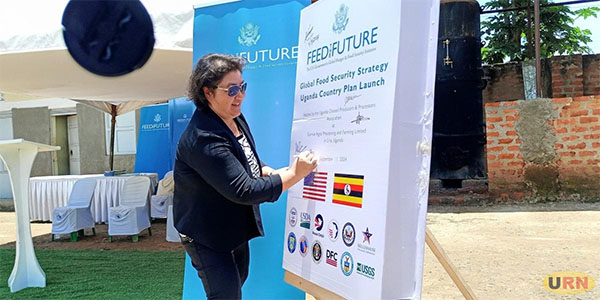
Agago, Uganda | THE INDEPENDENT | Leaders and farmers in the Lango and Acholi sub-region want the Uganda Global Food Security Strategy plan to address prices of seeds and markets for agricultural produce.
The U.S. government launched the strategy, a five-year plan which aims to end global hunger, and malnutrition through the Feed the Future Initiative.
The objectives of the plan are inclusive and sustainable agriculture-led growth, strengthened resilience among people and systems, and a well-nourished population, especially among women and children in 38 districts.
However, farmers say despite producing in large quantities, low prices and lack of markets result in losses. Some say the high cost and poor quality of seeds are also affecting their production.
Justine Okello, a farmer from Agago district argues that the only opportunity to improve profits is the availability of quality seeds and a ready market for their farm produce.
Okello Orik, the Lira LCV Chairperson wonders why farmers are buying a kilo of seeds at 70,000 shillings and being forced to sell a kilo of produce at 5,000 shillings.
Jonathan Cone, the USAID Uganda Deputy Mission Director explained that through the strategy, farmers will be provided with quality seeds to be able to produce nutritious crops and linked to available markets.
However, Christine Anono, the Lira District Community Development Officer argues that despite the plan, if farmers do not change their mindset and join cooperatives, the country will not be food secure.
She asked for special protection for women and children, the major stakeholders in Agriculture whom she says are very vulnerable.
Mia Beers, the USAID deputy assistant to the administrator in the bureau for resilience, environment and food security argues that Uganda despite being a regional food supplier has been subjected to repeated weather shocks, resulting in poor harvests and exacerbating food insecurity. Adding that the Uganda Country Plan is a reflection of the United States interagency investments to realizing African food security.
“The plan builds on past achievements and lessons learned, and prioritizes inclusive participation, value addition, climate adaptation, and job creation. The work you all do in Uganda will contribute to our ambitious global target-to reduce poverty and stunting by 20 percent.” She said.
Between 2006 and 2022, Uganda registered a decrease in rates of malnutrition in children under five from 38.7 percent to 24.4 percent and a 20I6 World Bank shows that the proportion of the population living below the national poverty line declined from 564 percent in 1993 to 19.7 percent in 2013.
However, stunting prevalence decline in poverty has reversed since then, increasing in many parts of the country especially the rural areas. In recent years, moderate and severe food insecurity also increased from 66.3 percent in 2014/16 to 74.2 percent in 2020/22.
This new strategy builds from the previous five-year strategy that was developed under the Global Food Security Act of 2016. The first strategy created a blueprint to effectively implement Feed the Future, the Sustainable Development Goals (SDGs), and the 2030 Agenda.
****
URN
 The Independent Uganda: You get the Truth we Pay the Price
The Independent Uganda: You get the Truth we Pay the Price



 Anthony Natif notes from Court: Prosecution case enters final stretch
Anthony Natif notes from Court: Prosecution case enters final stretch
